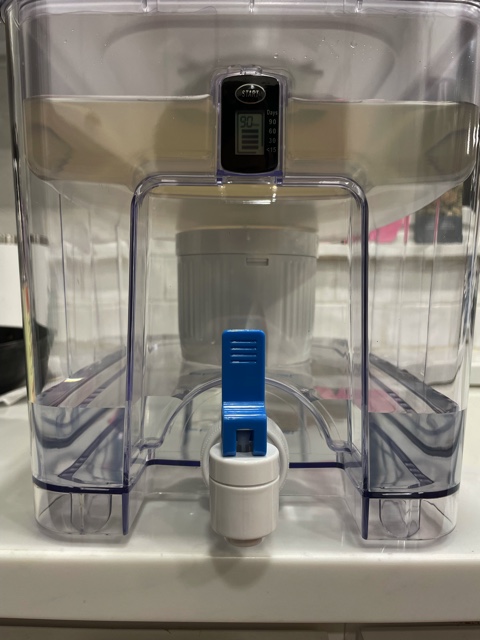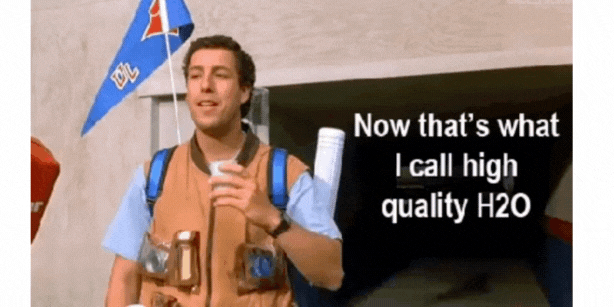
Today I wanted to write a piece on water and how water quality is an important aspect of our health. It should be no surprise to you that water is extremely important for our health. Around 60% of our body weight is made up of water and almost all aspects of our health are affected by water: digestion, detox, cellular functions, skin elasticity, cognition, weight management, and the list goes on. Most water we consume is through drinking water, but 20% of our water consumption comes indirectly through food. Therefore, it is paramount that the water we consume is clean and healthy for us.
Our municipal water supply is regulated by local facilities and standards set forth by the EPA. The role of city water treatment facilities is to monitor water quality and keep known contaminants below specific EPA standards. Water quality is routinely tested and reported — you can look up your water quality report at https://www.ewg.org/tapwater/. They also use chemicals to disinfect the water to protect us from harmful bacteria and viruses that have caused significant health risks in the past. Overall, our local water supplies do a very good job sticking within EPA parameters and keeping our water free from infectious agents. These protections have served to dramatically reduce pandemic levels deaths from diseases like cholera and to increase our lifespan.

As many of you know, our clinic is located in Asheville, NC, an area that was devastated by Hurricane Helene and the flooding that came along with this storm. Asheville’s main water treatment facility was almost completely washed away, along with extensive damage to many of its water pipes, causing massive water outages across the city. The local and federal agencies have worked tirelessly around the clock in order to restore water, and we are extremely appreciative of their hard work. These events have made me think about our water quality more than normal.
We are in a new age of water contamination. Today, the top sources of water contamination include industrial waste, agricultural runoff, household waste, pharmaceuticals, and byproducts from water chlorination. These sources introduce harmful chemicals like heavy metals, pesticides, pharmaceuticals, and disinfectant byproducts into the water supply, posing significant health risks. Most of these chemicals do not have EPA standards because they haven’t been fully studied. Others, like fluoride and PFAs (i.e. ‘forever chemicals’), have had their EPA legal limit lowered due to growing evidence of harm (Fluoride around 2015 and limits on PFAs will go into effect in 2029). Personally, I’d rather take simple steps to purify my water even further than wait on the EPA to tell me if something is harmful.
First, let’s talk about a few potentially harmful chemicals commonly found in water:
1. Fluoride:
Fluoride was added to the water supply in order to reduce dental cavities and strengthen teeth. Make no mistake, it has been extremely helpful for this. However, some studies show that fluoride, even at lower than EPA standards, may disrupt our hormone pathways and cause developmental problems in children. Of note: 41% of US adolescents have evidence of dental fluorosis, a condition that happens after too much fluoride exposure.

2. Chlorine Byproducts.
Chlorine is used to disinfect our water. However, as chlorine breaks down, it creates a lot of byproducts that may increase the risk of certain cancers and disrupt fetal development.
3. Heavy Metals.
These find their way into the water supply through old pipe systems, disrupted sediment, and industrial pollution. Increased heavy metal exposure is inflammatory in the body, worsen cognitive function, and can damage organs.
4. PFAs (‘forever chemicals’).
PFAs are used in industrial chemicals, nonstick cookware, and water repellent materials. PFA exposure increases risk of cancer, immune dysfunction, and developmental delays in children.
5. Microplastics.
Microplastics form during the breakdown of plastics in the environment. Microplastics can cause inflammation and disrupt the immune system. We will write about microplastics more later.
For almost everyone on city water, these chemicals will be low but present. Also, the EPA does not have safe cut-offs for many of these contaminants. Therefore, reducing your intake even further can be helpful for your long-term health. One major problem with our modern environment is that we are being exposed to these chemicals in a variety of ways throughout the day — in our food, water, the air we breathe, and the products that touch our skin. This can create a cumulative effect, with chemicals building up in our bodies over time.

How to improve your water quality even further:
Look up your water report at https://www.ewg.org/tapwater/, and know what your main contaminants are.
- Purchase a good water filter that filters these contaminants. Keep in mind that most refrigerator filters and table top pitchers do not do a good enough job clearing out PFAs, fluoride, and microplastics.
- If you want a pitcher/table top system, get one that has a strong filter (I like Epic Water or LifeStraw — I’m sure there are other good brands, too)
- Most under sink 2 or 3-system water filters work well.
- Reverse Osmosis filtration is the best overall but also tends to be more expensive.
- UV purification kills bacteria and viruses — can be good for wells
- Whole house filtration will also clear these chemicals from the water in your shower/bath.
- Improve your drinking vessel — Try to mostly drink from glass or stainless steel (including the straw!). Studies have shown that 1L of water in a plastic water bottle contains 240,000 plastic particles, 10-100x more than previously thought.
- I recommend filtering fluoride from your drinking water, especially if you have young children. Fluoride is found in all other beverages we consume, so you will still have some daily exposure. Also, studies have shown that fluoride in toothpaste provides enough fluoride to reduce your risk of dental cavities. If you are not going to filter fluoride in your water, I would advise using fluoride-free toothpaste.

I hope this summary was helpful. Though it can come across as alarmist, the intention is to help you better understand the important (and often simple) ways you can take better control of your health. Ensuring clean water is not hard but does require a few more steps than simply trusting what comes out of your tap water.
LISTEN HERE: Dr. Vickery also talked about water (Proper Hydration & Breathing) in a podcast on the Jason Wright show on 10/13/23.








